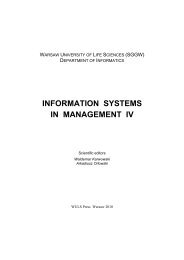62 L. Mazal, K.J. RowlesGDPt= GDP0+ a1t + εt[1]where t denotes time and ε t is a stationary cyclical component, which is a difference betweenthe estimated or expected GDP and the real observed GDP. The direct consequenceof trend stationarity is a temporary character of the cyclical component, which vanishesover time. Since this cyclical component always reverts to its mean, it has no permanentinfluence on the trending variable. In other words, under the assumption of output as atrending variable the recessions have only temporary effects on output that vanish overtime as the classical authorities supposed.INTERVENTIONISM: UNSTABLE STOCHASTIC GDPThe New Keynesian economics regards real GDP as a sum of independent randomshocks that do not vanish over time but have permanent influence on the level of the GDP.Cyclical deviations from the trend occur because of the productivity shocks due to technologicalchange. If these real factors cause aggregate fluctuations, then business cyclescannot be viewed as temporary. There is no invisible hand that draws economy back to itslong-run trend and long deep recessions are highly likely. Thus from this point of view,the New Keynesian economics provides justification for state interventionism.The New Keynesian economics in fact assumes that output is a difference stationaryvariable, which means that it contains a unit root or random walk process. If GDPcontains a unit root, it means that GDP is a function of time and the cumulative sum ofrandom disturbances, or error terms. More preciselytGDP = GDP0 + a1t+ ε [2]ti=1iwhere the term a 1 refers to the drift of output. It is evident from the equation 2 that thefirst difference of the GDP is a sum of constant growth rate and error term or cyclical stochasticcomponent ε t . Since the error term has variance σ and not one, it is possible thatεt> a 1which means that this stochastic component completely overtakes the influenceof constant growth rate a 1 and GDP deviates from this constant trend in long run [Enders2004]. In this case, error terms do not have temporary effects. These cyclical randomshocks have a permanent effect, because they are not stationary. Output in period t2 isdetermined by the output in the period t1. This change in output persists in every futureperiod, which means that recessions have permanent effects on output. Therefore, theonly possible way of stationarisation is differencing. In other words, there is no trend inGDP, there is only increasing tendency caused by the drift term.Unit root has also important consequences in terms of theoretical economics. Snowdonand Vane [2005] state that: “If shocks to productivity growth due to technologicalchange are frequent and random, then the path of output following a random walk willexhibit features that resemble a business cycle” [Snowdon and Vane 2005, p. 303]. However,in this case the observed fluctuations in GDP are not deviations from a deterministictime trend. These deviations are fluctuations in the “natural (trend) rate of output”Acta Sci. Pol.
Economic Policy in Central Eastern Europe: Unit Root Consequences 63[Snowdon and Vane 2005, p. 303] caused by a series of permanent shocks. Thus, eachproductivity shock is permanent and determines a new growth path.Now, if the issue concerns the justification or legitimacy of economic policy interventionsthan the question is whether output is trend stationary or difference stationary.Snowdon and Vane [2005] state:“If business cycles are temporary events, then recessions create no long-run adverseeffects on GDP. However, whereas Keynesians feel that such deviations could be severeand prolonged and therefore justify the need for corrective action, monetarists, and especiallynew classical economists, reject the need for activist stabilization policy, havinggreater faith in the equilibrating power of market forces and rules-based monetary policy”[Snowdon and Vane 2005, p. 300].In order to determine whether economies need corrective actions, a distinction mustbe made as to whether outputs are difference stationary or trend stationary. In other words,do outputs fluctuate around deterministic trend or are they purely stochastic without anyclear trend? More precisely, in order to answer the question we need to prove if the equation3 contains a unit root.GDPt GDP t= GDP + a t + a + ε[3]0 2 1 −1 tNelson and Plosser’s groundbreaking study [1982] indicates that the U.S. GDP ispurely stochastic without any stable trends. On base of the Dickey-Fuller test [Dickey andFuller 1979], they were not able to reject the null hypothesis of unit root in the case of realGNP, nominal GNP, industrial production, and unemployment rate of the United States.In particular, non-rejection of unit root in the case of real GNP had very strong influenceon theoretical macroeconomics as well as on practical macroeconomic policy.“The most important implication of the unit root revolution, is that under this hypothesisrandom shocks have a permanent effect on the system. Fluctuations are not transitory.This implication, as forcefully argued by Nelson and Plosser, has profound consequencesfor business cycle theories. It runs counter to the prevailing view that business cycles aretransitory fluctuations around a more or less stable trend path” [Perron 1989, p. 1362].Many other studies dealt with the unit root testing by using U.S. data, as for instance,Rudenbusch [1992], Simkins [2001] or Andreou and Spanos [2003]. Furthermore, Fleissigand Strauss [1999] applied panel unit root tests to examine if real per capita GDP forOECD economies are trend or difference stationary. They conclude that the results failto reject the null hypothesis of unit root. Similarly, Narayan [2006] explored per capitaincome of G7 countries in the period 1870–2001. He was able to reject the unit root hypothesisin case of five countries of G7. Smyth and Inder [2003] used real GDP per capitain 25 of China’s provinces to test the unit root. They concluded that the evidence supportsthe unit root hypothesis if they allowed no structural breaks or one structural break. Incase of more than one break and in case of breaks in intercept and slope the results weremixed. Li [2000] examines China’s output data and concludes that the data are “flexibletrend stationary rather than difference stationary” [Li 2000, p. 825]. However, thesestudies have not examined economies the Central and Eastern Europe and the aim of thispaper is to provide an extension of previous studies to the CEE4.Oeconomia 10 (1) 2011
- Page 6 and 7:
6 A. Gawrońska, S. Paszkowskicultu
- Page 8 and 9:
8 A. Gawrońska, S. Paszkowskinumbe
- Page 10 and 11:
10 A. Gawrońska, S. PaszkowskiTabl
- Page 12: 12 A. Gawrońska, S. PaszkowskiTabl
- Page 15 and 16: The distribution of social security
- Page 17 and 18: %180,0160,0140,0120,0100,080,060,04
- Page 19: The distribution of social security
- Page 22 and 23: 22 R. Hryniewski, W. Mądry, D. Goz
- Page 24 and 25: 24 R. Hryniewski, W. Mądry, D. Goz
- Page 26 and 27: 26 R. Hryniewski, W. Mądry, D. Goz
- Page 28 and 29: 28 R. Hryniewski, W. Mądry, D. Goz
- Page 30 and 31: 30 R. Hryniewski, W. Mądry, D. Goz
- Page 32 and 33: 32 R. Hryniewski, W. Mądry, D. Goz
- Page 35 and 36: Oeconomia 10 (1) 2011, 35-43EDUCATI
- Page 37 and 38: Education as an element of competit
- Page 39 and 40: Education as an element of competit
- Page 41 and 42: Education as an element of competit
- Page 43: Education as an element of competit
- Page 46 and 47: 46 E. Majewski, P. Sulewski, M. Rag
- Page 48 and 49: 48 E. Majewski, P. Sulewski, M. Rag
- Page 50 and 51: 50 E. Majewski, P. Sulewski, M. Rag
- Page 52 and 53: 52 E. Majewski, P. Sulewski, M. Rag
- Page 54 and 55: 54 E. Majewski, P. Sulewski, M. Rag
- Page 56 and 57: 56 E. Majewski, P. Sulewski, M. Rag
- Page 58 and 59: 58 L. Mazal, K.J. RowlesIn the West
- Page 60 and 61: 60 L. Mazal, K.J. RowlesThe most im
- Page 64 and 65: 64 L. Mazal, K.J. RowlesTHE TIME SE
- Page 66 and 67: 66 L. Mazal, K.J. RowlesTable 4. Ac
- Page 68 and 69: 68 L. Mazal, K.J. RowlesNelson Ch.R
- Page 70 and 71: 70 A. Ptak-Chmielewskastatistics, w
- Page 72 and 73: 72 A. Ptak-Chmielewska3025birth rat
- Page 74 and 75: 74 A. Ptak-ChmielewskaSECTOR OF ACT
- Page 76 and 77: 76 A. Ptak-Chmielewskabirth rate fo
- Page 78 and 79: 78 A. Ptak-Chmielewskawere trade fi
- Page 80 and 81: 80 A. Ptak-ChmielewskaREFERENCESBal
- Page 83 and 84: Oeconomia 10 (1) 2011, 83-95THE EFF
- Page 85 and 86: The effi ciency of selected real es
- Page 87 and 88: The effi ciency of selected real es
- Page 89 and 90: Table 1. Efficiency of real estate
- Page 91 and 92: The effi ciency of selected real es
- Page 93 and 94: The effi ciency of selected real es
- Page 95: The effi ciency of selected real es
- Page 98 and 99: 98 J. Sosnowski, G.A. CiepielaJalin
- Page 100 and 101: 100 J. Sosnowski, G.A. Ciepiela2007
- Page 102 and 103: 102 J. Sosnowski, G.A. CiepielaTabl
- Page 104 and 105: 104 J. Sosnowski, G.A. CiepielaTabl
- Page 106 and 107: 106 J. Sosnowski, G.A. Ciepiela1400
- Page 108 and 109: 108 J. Sosnowski, G.A. CiepielaOsek
- Page 110 and 111: 110 E. SzymańskaProducts by Activi
- Page 112 and 113:
112 E. Szymańskatroduced TFI which
- Page 114 and 115:
114 E. Szymańskabers of companies
- Page 116 and 117:
116 E. SzymańskaTable 3. Tourism v
- Page 118 and 119:
118 E. SzymańskaREFERENCESCoccossi
- Page 120 and 121:
120 J. WiśniewskaEvery society can
- Page 122 and 123:
122 J. WiśniewskaStatistical analy
- Page 124 and 125:
124 J. WiśniewskaCommon Agricultur
- Page 126 and 127:
126 J. WiśniewskaTable 3. An attem
- Page 128 and 129:
128 J. Wiśniewskathe application o
- Page 130 and 131:
130 J. Wiśniewskainstitutional cos
- Page 132 and 133:
132 J. Wiśniewskaemployed in agric
- Page 134 and 135:
134 J. WiśniewskaLong term viabili
- Page 136 and 137:
136 J. Wiśniewska--The level of re
- Page 139 and 140:
Oeconomia 10 (1) 2011, 139-148INNOV
- Page 141 and 142:
Innovativeness of food production e
- Page 143 and 144:
Innovativeness of food production e
- Page 145 and 146:
Innovativeness of food production e
- Page 147 and 148:
Innovativeness of food production e
- Page 149 and 150:
Oeconomia 10 (1) 2011, 149-158LOCAL
- Page 151 and 152:
Local governance activities in supp
- Page 153 and 154:
Local governance activities in supp
- Page 155 and 156:
Local governance activities in supp
- Page 157 and 158:
Local governance activities in supp
- Page 159 and 160:
Oeconomia 10 (1) 2011, 159-169CHANG
- Page 161 and 162:
Changes in rural women’s movement
- Page 163 and 164:
Changes in rural women’s movement
- Page 165 and 166:
Changes in rural women’s movement
- Page 167 and 168:
Changes in rural women’s movement
- Page 169:
Changes in rural women’s movement
- Page 172:
Ewa SzymańskaTourism function of M
















